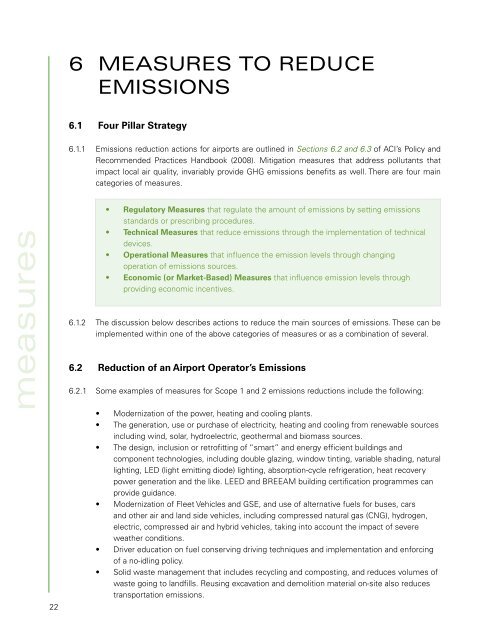Airport Greenhouse Gas Emissions Management - Zurich Airport
Airport Greenhouse Gas Emissions Management - Zurich Airport
Airport Greenhouse Gas Emissions Management - Zurich Airport
Create successful ePaper yourself
Turn your PDF publications into a flip-book with our unique Google optimized e-Paper software.
6 MEASURES TO REDUCE<br />
EMISSIONS<br />
6.1 Four Pillar Strategy<br />
6.1.1 <strong>Emissions</strong> reduction actions for airports are outlined in Sections 6.2 and 6.3 of ACI’s Policy and<br />
Recommended Practices Handbook (2008). Mitigation measures that address pollutants that<br />
impact local air quality, invariably provide GHG emissions benefits as well. There are four main<br />
categories of measures.<br />
measures<br />
22<br />
• Regulatory Measures that regulate the amount of emissions by setting emissions<br />
standards or prescribing procedures.<br />
• Technical Measures that reduce emissions through the implementation of technical<br />
devices.<br />
• Operational Measures that influence the emission levels through changing<br />
operation of emissions sources.<br />
• Economic (or Market-Based) Measures that influence emission levels through<br />
providing economic incentives.<br />
6.1.2 The discussion below describes actions to reduce the main sources of emissions. These can be<br />
implemented within one of the above categories of measures or as a combination of several.<br />
6.2 Reduction of an <strong>Airport</strong> Operator’s <strong>Emissions</strong><br />
6.2.1 Some examples of measures for Scope 1 and 2 emissions reductions include the following:<br />
• Modernization of the power, heating and cooling plants.<br />
• The generation, use or purchase of electricity, heating and cooling from renewable sources<br />
including wind, solar, hydroelectric, geothermal and biomass sources.<br />
• The design, inclusion or retrofitting of “smart” and energy efficient buildings and<br />
component technologies, including double glazing, window tinting, variable shading, natural<br />
lighting, LED (light emitting diode) lighting, absorption-cycle refrigeration, heat recovery<br />
power generation and the like. LEED and BREEAM building certification programmes can<br />
provide guidance.<br />
• Modernization of Fleet Vehicles and GSE, and use of alternative fuels for buses, cars<br />
and other air and land side vehicles, including compressed natural gas (CNG), hydrogen,<br />
electric, compressed air and hybrid vehicles, taking into account the impact of severe<br />
weather conditions.<br />
• Driver education on fuel conserving driving techniques and implementation and enforcing<br />
of a no-idling policy.<br />
• Solid waste management that includes recycling and composting, and reduces volumes of<br />
waste going to landfills. Reusing excavation and demolition material on-site also reduces<br />
transportation emissions.

















